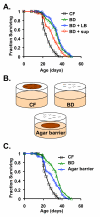Age- and calorie-independent life span extension from dietary restriction by bacterial deprivation in Caenorhabditis elegans
- PMID: 18457595
- PMCID: PMC2408926
- DOI: 10.1186/1471-213X-8-49
Age- and calorie-independent life span extension from dietary restriction by bacterial deprivation in Caenorhabditis elegans
Abstract
Background: Dietary restriction (DR) increases life span and delays age-associated disease in many organisms. The mechanism by which DR enhances longevity is not well understood.
Results: Using bacterial food deprivation as a means of DR in C. elegans, we show that transient DR confers long-term benefits including stress resistance and increased longevity. Consistent with studies in the fruit fly and in mice, we demonstrate that DR also enhances survival when initiated late in life. DR by bacterial food deprivation significantly increases life span in worms when initiated as late as 24 days of adulthood, an age at which greater than 50% of the cohort have died. These survival benefits are, at least partially, independent of food consumption, as control fed animals are no longer consuming bacterial food at this advanced age. Animals separated from the bacterial lawn by a barrier of solid agar have a life span intermediate between control fed and food restricted animals. Thus, we find that life span extension from bacterial deprivation can be partially suppressed by a diffusible component of the bacterial food source, suggesting a calorie-independent mechanism for life span extension by dietary restriction.
Conclusion: Based on these findings, we propose that dietary restriction by bacterial deprivation increases longevity in C. elegans by a combination of reduced food consumption and decreased food sensing.
Figures






Similar articles
-
Autophagy is required for dietary restriction-mediated life span extension in C. elegans.Autophagy. 2007 Nov-Dec;3(6):597-9. doi: 10.4161/auto.4989. Epub 2007 Sep 6. Autophagy. 2007. PMID: 17912023
-
Life extension via dietary restriction is independent of the Ins/IGF-1 signalling pathway in Caenorhabditis elegans.Exp Gerontol. 2003 Sep;38(9):947-54. doi: 10.1016/s0531-5565(03)00161-x. Exp Gerontol. 2003. PMID: 12954481
-
Dietary restriction by bacterial deprivation increases life span in wild-derived nematodes.Exp Gerontol. 2008 Mar;43(3):130-5. doi: 10.1016/j.exger.2007.10.019. Epub 2007 Nov 17. Exp Gerontol. 2008. PMID: 18083317 Free PMC article.
-
Ketone bodies mimic the life span extending properties of caloric restriction.IUBMB Life. 2017 May;69(5):305-314. doi: 10.1002/iub.1627. Epub 2017 Apr 3. IUBMB Life. 2017. PMID: 28371201 Review.
-
Diet and aging.Cell Metab. 2008 Aug;8(2):99-104. doi: 10.1016/j.cmet.2008.06.012. Cell Metab. 2008. PMID: 18680711 Review.
Cited by
-
Endogenous DAF-16 spatiotemporal activity quantitatively predicts lifespan extension induced by dietary restriction.Commun Biol. 2023 Feb 20;6(1):203. doi: 10.1038/s42003-023-04562-2. Commun Biol. 2023. PMID: 36807646 Free PMC article.
-
Lactobacillus rhamnosus Lcr35 as an effective treatment for preventing Candida albicans infection in the invertebrate model Caenorhabditis elegans: First mechanistic insights.PLoS One. 2019 Nov 6;14(11):e0216184. doi: 10.1371/journal.pone.0216184. eCollection 2019. PLoS One. 2019. PMID: 31693670 Free PMC article.
-
Tether mutations that restore function and suppress pleiotropic phenotypes of the C. elegans isp-1(qm150) Rieske iron-sulfur protein.Proc Natl Acad Sci U S A. 2015 Nov 10;112(45):E6148-57. doi: 10.1073/pnas.1509416112. Epub 2015 Oct 26. Proc Natl Acad Sci U S A. 2015. PMID: 26504246 Free PMC article.
-
Diacetyl odor shortens longevity conferred by food deprivation in C. elegans via downregulation of DAF-16/FOXO.Aging Cell. 2021 Jan;20(1):e13300. doi: 10.1111/acel.13300. Epub 2020 Dec 31. Aging Cell. 2021. PMID: 33382195 Free PMC article.
-
The MDT-15 subunit of mediator interacts with dietary restriction to modulate longevity and fluoranthene toxicity in Caenorhabditis elegans.PLoS One. 2011;6(11):e28036. doi: 10.1371/journal.pone.0028036. Epub 2011 Nov 21. PLoS One. 2011. PMID: 22132200 Free PMC article.
References
-
- Weindruch RH, Walford RL. The Retardation of Aging and Disease by Dietary Restriction. Springfield, IL. , Thomas; 1988. - PubMed
-
- Miller RA, Buehner G, Chang Y, Harper JM, Sigler R, Smith-Wheelock M. Methionine-deficient diet extends mouse lifespan, slows immune and lens aging, alters glucose, T4, IGF-I and insulin levels, and increases hepatocyte MIF levels and stress resistance. Aging Cell. 2005;4:119–125. doi: 10.1111/j.1474-9726.2005.00152.x. - DOI - PMC - PubMed
-
- Orentreich N, Matias JR, DeFelice A, Zimmerman JA. Low methionine ingestion by rats extends life span. J Nutr. 1993;123:269–274. - PubMed
Publication types
MeSH terms
Substances
Grants and funding
LinkOut - more resources
Full Text Sources
Other Literature Sources

